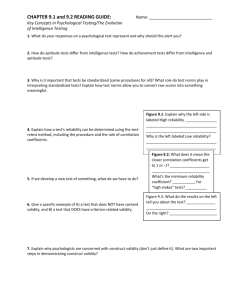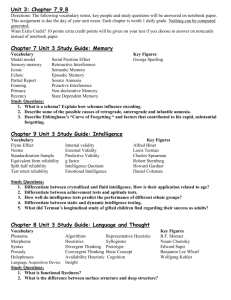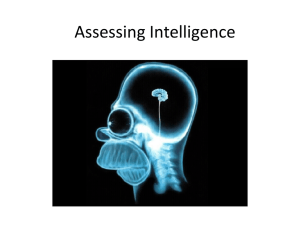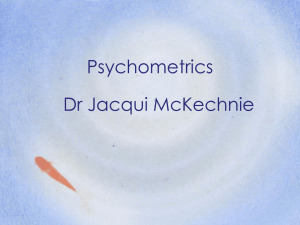ap psychology review - intelligence
advertisement
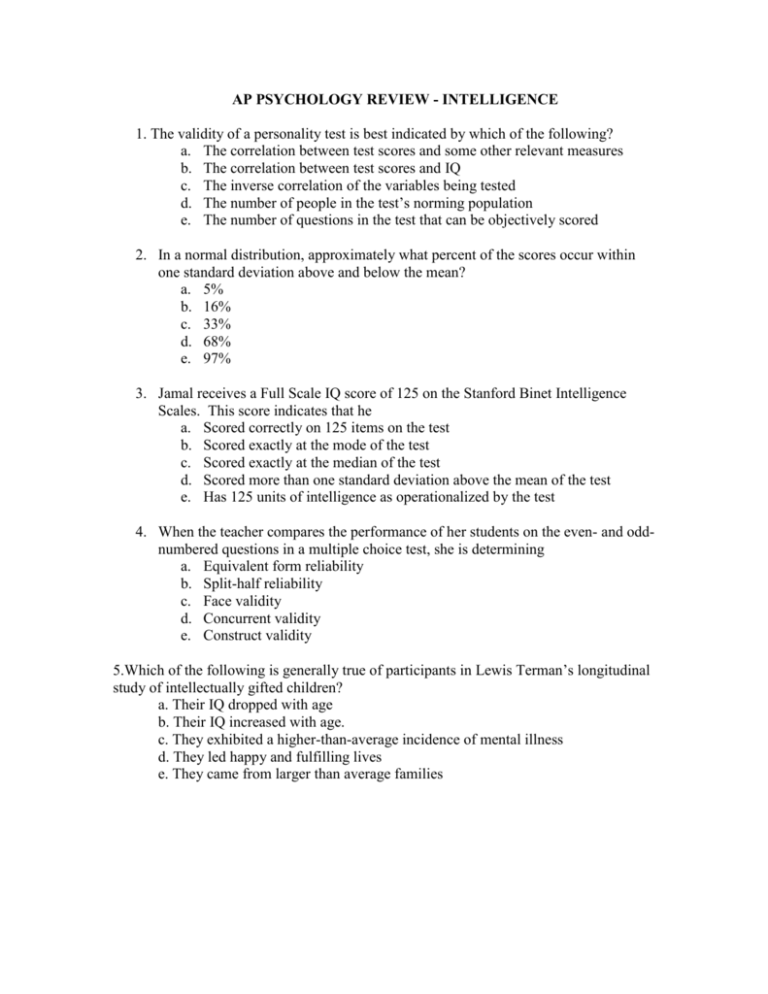
AP PSYCHOLOGY REVIEW - INTELLIGENCE 1. The validity of a personality test is best indicated by which of the following? a. The correlation between test scores and some other relevant measures b. The correlation between test scores and IQ c. The inverse correlation of the variables being tested d. The number of people in the test’s norming population e. The number of questions in the test that can be objectively scored 2. In a normal distribution, approximately what percent of the scores occur within one standard deviation above and below the mean? a. 5% b. 16% c. 33% d. 68% e. 97% 3. Jamal receives a Full Scale IQ score of 125 on the Stanford Binet Intelligence Scales. This score indicates that he a. Scored correctly on 125 items on the test b. Scored exactly at the mode of the test c. Scored exactly at the median of the test d. Scored more than one standard deviation above the mean of the test e. Has 125 units of intelligence as operationalized by the test 4. When the teacher compares the performance of her students on the even- and oddnumbered questions in a multiple choice test, she is determining a. Equivalent form reliability b. Split-half reliability c. Face validity d. Concurrent validity e. Construct validity 5.Which of the following is generally true of participants in Lewis Terman’s longitudinal study of intellectually gifted children? a. Their IQ dropped with age b. Their IQ increased with age. c. They exhibited a higher-than-average incidence of mental illness d. They led happy and fulfilling lives e. They came from larger than average families Alfred Binet – father of intelligence testing Lewis Terman – translated Binet’s test into English, longitudinal study Charles Spearman – “G” such thing as general intelligence Louis Thurstone – eight primary mental abilities J. P. Guilford – cube model – over 200 mental abilities Raymond Cattell – crystallized and fluid intelligence crystallized intelligence – ability to absorb and retain information Fluid intelligence – ability to solve problems not seen before, speed and flexibility in solving problems (declines with age) Robert Sternberg’s triarchic theory – three kinds of intelligence, creative, practical and analytic Howard Gardner’s theory of multiple intelligences – Linguistic, logical-mathematical, musical, spatial, bodily-kinesthetic, interpersonal, intrapersonal, naturalistic Normal distribution – bell curve Standard deviation – statistical measure of spread of scores Mental age – comparing child’s chronological age to the previously determined average mental ability for that age (norm) 7 year testing at typical 7 – mental age of 7 IQ – MA/CA x 100 Projective tests – Rorschach and Thematic Apperception Test (TAT) MMPI – personality test Myers Brigs Inventory – self report personality test Standardized – same manner to everyone Norms – representative sample of individuals similar to the population Reliability – consistency of scoring procedures Validity – does the test assess what it claims to assess Test-retest reliabilitydoes the score you receive on a test correlate with your later performance on the same test Equivalent form reliability – does the score you receive on a test correlate with the score you receive on another test of the same material Split half reliability – does your score on the first half of a test correlate with your score on the second half of the test Inter-rater reliability – does the score one grader assigns to your assessment correlate with the score another grader gives on that test Face validity – with a quick perusal of the assessment, does the test seem to evaluate what it claims to evaluate Content validity – does the assessment test the body of material – content it is supposed to test Construct validity – does the assessment accurately test what you have defined as the characteristics (constructs) you wish to assess Criterion validity – do the results from the assessment correlate with results from other measures designed to assess similar or related things Predictive validity – does the test accurately forecast the level of some future performance


